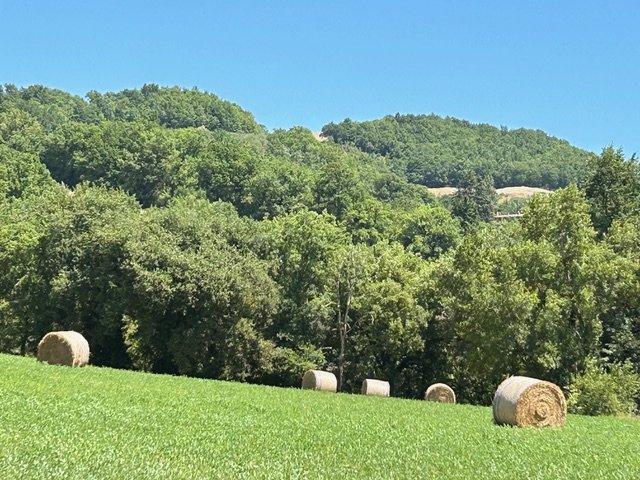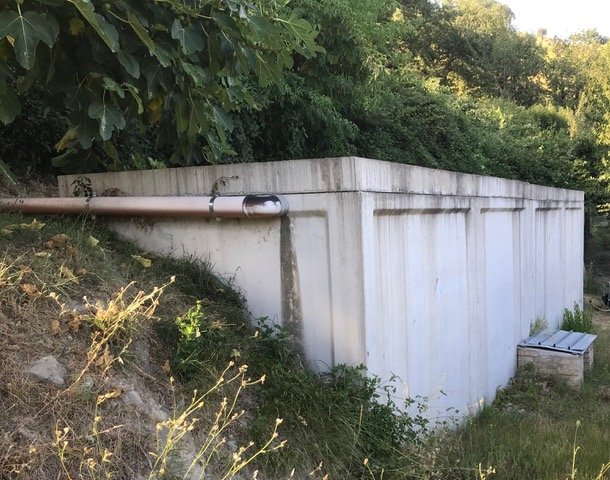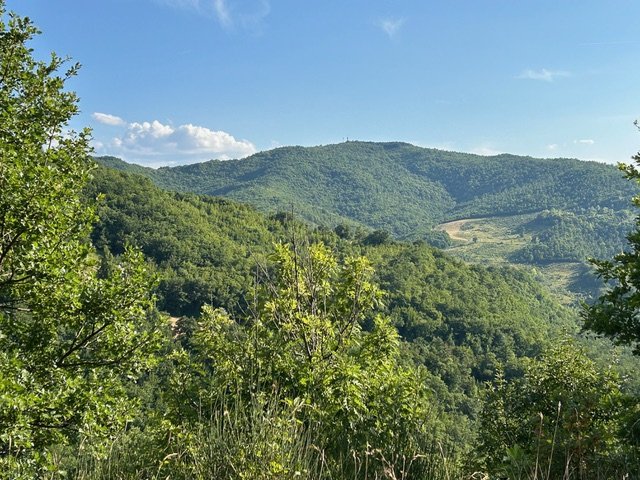FARM LIKE AN ECOSYSTEM PART IV: Rainwater Harvesting
In Sicily... a farmer watched recently as his cows headed to the slaughterhouse. After months of drought, he didn't have any water or food to give them. “It’s devastating,” said the farmer, Lorenzo Iraci Sareri, as tears fell on his tanned face, lined by 40 years of labor pasturing cows. “I have never seen something like this...” In north-eastern Sardinia... officials had to make a choice between tourism and agriculture, and completely halted running water for irrigation. “We decided to sacrifice agriculture,” said Giancarlo Dionisi, the local prefect of the Sardinian province of Nuoro. While farmers would be compensated for their losses, he said, the damage of having waterless hotels could last longer. “If tourists who come can’t shower, they create a negative word of mouth,” he said. New York Times July 24, 2024
WHAT?
Wait... let me get this straight. Water for tourists but not for farmers? When did we volunteer for the forced march of continued economic growth: damn all life forms, full speed ahead. And why are there still tourists traveling and belching fossil fuel emissions when all that we love is right on the edge of collapse? Our collective intentional ignorance is primed to force all things beautiful over the precipice with us.
Italy was the land of family. The Family Farm was an institution. Family, land, and the food it produced was the holy trinity on which country folk built their lives. And farmers have always been dependent on the water supply—the rainfall, the river, and the underground springs. So it was shocking to read that the Sicilian farmers were not prepared, somehow imagined they would have unlimited water from the local government. As we continue to stick our heads in the ground, the temperature continues accelerating. This summer has been the hottest summer on record. And it has been hotter every summer for years.
The farmers in central Italy, where I live, were not taken by surprise. Winter is much diminished now. Spring lasts two or three weeks. In my region of Umbria, the wheat and hay—two of our main crops—must be harvested by mid-June in anticipation of the usual and progressively harsher summer drought. Hot dry summers have been typical since the beginning of Umbrian agriculture. From mid-June, almost all our fields lie fallow until the rain returns in September. No one irrigates using comune water. We simply wait for rain. And when there is none, we don't plant. And each year we wait a little longer, a little later, for the rain to swell the grapes in the vineyard and the olives in our orchards. It may not be until October, sometimes November, before the harvest begins.
The same field, one week later
Every high school student who has had a brush with rudimentary science knows about the 1.5 Celsius threshold, that critical average temperature increase since pre-industrial times, the point where the impacts of climate change become increasingly severe. It has been in the newspapers daily, for years. This is not rocket science; put more heat-trapping emissions into our atmosphere and it will become hotter. This threshold has been breached for a year now, according to the EU's Copernicus Climate Change Service. Our collective denial is terrifying. For over fifty years, the environmental movement has not gotten its message across; oil drilling, deforestation, biodiversity loss, species extinction, water degradation, fertilizer mining and manufacturing, soil erosion and degradation, intensive animal farming, global transport... (the list is long and depressing) have all increased. And now, in Sicily, the resource essential to all of life—our fresh water—is more important for a tourist's shower than for growing food.
Storing Water
Cisterns for rainwater collection have been around since the Neolithic Age. The Roman empire saw long periods of drought and, as the empire grew, it also developed sophisticated aqueducts to move water to where it was needed (the cities) and cisterns to store and filter it. Water storage ranged from simple clay pots buried in the ground to enormous underground structures. European medieval castles, prominent at the top of many hilltowns, have cisterns carved into the stone beneath them. Most of my neighbors live on land which has been in the family for many generations, most are sitting over medieval cisterns carved into the rock foundation. (And many are still in use.) Our old stone house did not have a cistern but man-made ones were readily available—concrete is cheap, stainless steel more expensive. A simple glance at illustrations in a permaculture manual—no reading necessary—shows how to site a cistern off a roof. It’s really just a gutter, a pipe and a hollow container below. It can be of any size. If the container is sitting just above where the water is needed, gravity takes care of the flow for irrigation . It takes a little planning. Consider it insurance.
This is our largest cistern buried in the ground
One of my first lessons when I moved to Italy was that my very American sense of individuality was a handicap. I was now part of a very closely knit community. We were all dependent on one another. Water is something we all share. And though the land we bought had a functioning well, my neighbors were all conscious of the amount of water used. The ground water, the underground springs which feed our wells, even the city water are all shared. We use a lot of water—for our gardens and our animals—and have a number of containers. One good deluge, collected off numerous large surfaces, and the cisterns are full. Our largest cistern, in precast concrete, holds 52,000 liters. It harvests the rainwater off the roof of our house and can easily supply enough water to irrigate all the gardens. I don't want to depend on city water because I worry about its safety and availability in the future. Concrete is omnipresent and therefore cheap in Italy. Getting it here and installing it though involved an enormous crane for moving all the pieces in place, as well as a crew of people to stand on the road and argue about how to do it.
But it was necessary. And the cost of the cistern, divided over the eight years we have been on the land, is far less than the annual bill for city water for a family of four. For drinking, a passive activated carbon filter keeps out any contaminant large than 0.0001 microns. Boiling the water is also an option.
The donkey barn has a 3,000 liter cistern which supplies enough drinking water to the animals as well as water for cleaning their buckets and stalls. The well irrigates the potato field. And because we have no centralized sewage system out in the country, our waste lines from the house go underground and to the field below the house. The rainwater and wastewater we collect on the land stays on the land. No fossil fuel energy needed, no pumping station, no sanitation engineering required. (And no cholera as the sewage line goes through a bacterial digester before leaching into the soil.) Out here in The Boonies this is common, cheap and effective. Its been going on for centuries. All our household water and sewage becomes food.
Trees
When I folded up shop and quit the city, quit the U.S. for the outback of Europe, I was not looking for a farm. Instead, whether I had to rent, buy or barter I wanted a small bit of land… land returning to the wild, land where I could grow enough for my family's needs, make a little money. But I also wanted the beauty and the grounding that only a natural environment can provide. And the security. This meant land which was part forest, part fields. My older neighbors say if you had a small amount of land during the wars you survived. If you had no land you starved. And practically speaking, the research I was reading seemed to indicate that plants in a climax community, a mature ecosystem, are far more successful at maintaining a fertile soil community while holding moisture and nutrients, than open land which has been plowed and repeatedly monocropped.
Today is August 7. We passed the hottest day of the year, the hottest day ever, three days ago. 37 Celcius. But, except for a little spitting of rain in early July there has been no rain for a month and a half. This is what every July looks like here. Except now its hotter. Looking at my valley, the trees are still green. In some places, so is the grass. The fields, those which were harvested and then plowed mid-June, are yellow and non-productive. The fields where the hay was cut but were not plowed, are green and dotted with wild flowers. What's going on? Our fragile yet valiant forest ecosystem is vibrant, holding (perhaps sharing?) moisture. There are as many stands of trees as there are fields. Hedgerows divide the cropped land. The trees and the forest are holding enough water for the entire mountainside to remain alive.
I went back and studied the photos of the Sicilian drought from the article in the New York Times. The photos of the drought were photos of deserts; sand, dried grasses, a very few scattered trees in one photo. The rest were of wasteland. Not at tree in sight. And that is how it was with all the drought photos from souther Spain to Greece, long stretches of cracked earth, no trees. Trees/forests and rainwater storage, they go together. Trees and drought mitagation. Trees as protection from erosion caused by flooding. Again, not rocket science.
Unsolicited advice to the Sicillain farmers...
Save rainwater, an invaluable resource. In any receptacle you can afford. Don't divert flood water away from your land. Store as much water as you can. If you can't buy a cistern, create a pond, any sort of place in which you can store water.
Grow only as much food in the summer as the amount of your stored water can support. Farm most intensively during your wet season.
Plant trees. The single most useful plant on a farm is a tree. It will regulate water and nutrients for the entire surrounding soil community. Plant trees around the house, trees in the gardens and fields and hedgerows. Orchards of trees. Forests of trees. Food trees (for all types of animals). They will cool the area and keep the crops from baking in the sun.
For simplicity, for less work, fit the crops and the animals to the conditions. Know what prospers in the area... in this heat.
And ignore any advice involving BUYING something to make farming easier. It only means working longer hours to pay the bill. The lush forest never got the message that the soil needed biochar to be productive or plastic (plastic!) tubing for drip irrigation to dispense chlorinated city water.
A large part of sustainable farming, sustainable living, is about planting more trees and saving rain. It’s about farming like an ecosystem, imitating what Mother Nature does with her forests and meadows. If some of the trees are fruit or nut bearing, all the better. Planting trees and enjoying their benefits can be done wherever one can make deep fertile ground. Water catchment can be off any sloping surface
The woodlands around my house are still lush and green. In fact, the entire forested area of my valley looks as it did during the spring rains. But there is no rain. And at the forest’s edge—on the paths and in the meadows—are the usual suspects: the entire range of the local medicinal plants, wildflowers, edible weeds, wild fruit and nut trees. I harvested Saint John's wort until early July. We are still eating bunches of fat purslane in our salads. The fig trees guarantee me that it will be another stellar harvest. Same with the walnuts. And this year, with the heat, the echinacea, mugwort and motherwort were still splendid. An entire pharmacy and greengrocer, gratis, at the wood's edge. So much vitality and all being nurtured by the trees. Their moisture-holding capacity, nutrient storage and sharing within the ecosystem are not just an asset but essential during this drought. Cutting down the forest to have flat fields a tractor can drive is more than counterproductive. Its a death wish.
Mother Nature—in spite of all the abuse she has taken from us, in spite of our imagining that our humanity, our science, our agricultural “advances' are superior—still knows what works far better than we do. Simply put, her trees hold onto the rainwater when it is plentiful and disperse it when it is needed. I like to say that I follow right behind her imitating her dance steps. We can farm like an ecosystem, we can hold onto the rainwater and disperse it when needed. And, with trees nearby, they do much of the work for us.
Why aren't we paying attention?
©www.thesubversivefarmer.net.
In a previous lifetime, Zia Gallina worked as a botanist for the National Parks Service, on the C&O Canal outside of Washington D.C. (lecturing on wild indigenous and naturalized medicinal and culinary plants). She was also an adjunct professor teaching biology and environmental science at American University, Washington D.C. But she has always been a champion of small-scale biointensive farming, tagging behind Mother Nature, trying to stay as close as she can get.





